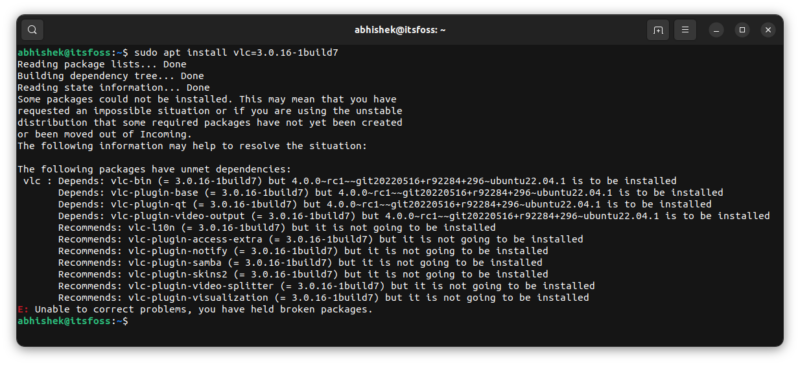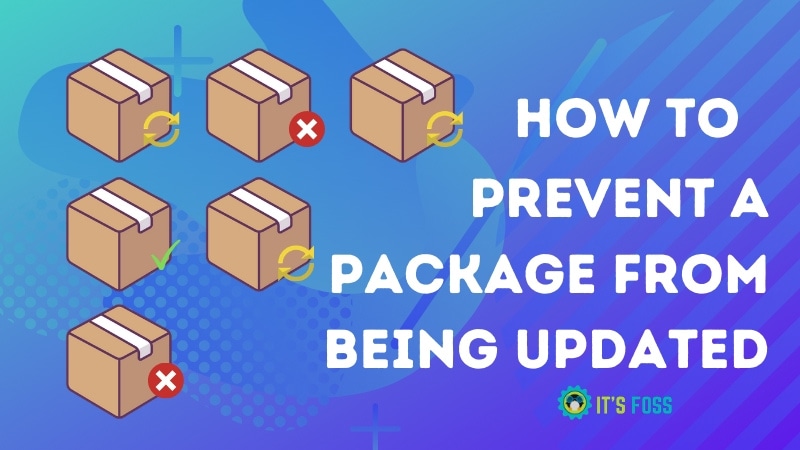
Want to install a specific version of a package in Ubuntu? You can do that ‘easily’ in the following manner:
sudo apt install package_name=package_versionHow do you know which versions are available for a certain package? Use this command:
apt list --all-versions package_nameIn the screenshot below, you can see that I have two versions of VLC available and I use the command to install the older version:

Sounds like a simple task, right? But things are not as simple as they look. There are several ifs and buts involved here.
This tutorial will cover all the important aspects of installing a specific program version using apt or apt-get commands.
Things to know about installing a specific version of a program
You need to know a few things about how APT and repositories work in Ubuntu and Debian-based distributions.
No older versions from the same source
Ubuntu doesn’t keep older versions of packages in the repository. You may see more than one version in specific cases, temporarily. For example, you run the apt update (but not upgrade), and a new version is available. You may see two versions for the same package in the apt cache. But as soon as the package is upgraded to the new version, the older version is removed from the cache as well as the repositories.
Use multiple sources for different versions
To get multiple versions of the same package, you’ll have to add multiple sources. For example, VLC is in version 3.x. Adding the VLC daily build PPA will give the (unstable) version 4.x.
Similarly, you can download a DEB file with a different version and install it.
The higher version always gets the priority
If you have the same package available from more than one source, by default, Ubuntu will install the highest available version.
In the previous example, if I install VLC, it will install version 4.x, not 3.x.
The older version gets upgraded to the available newer version
That’s another potential problem. Even if you install the older version of a package, it gets upgraded to the newer version (if available). You have to hold the package and stop it from upgrading.
Dependencies also need to be installed
If the package has dependencies, you’ll have to install the required version of the dependent packages as well.
Now that you know a few potential issues let’s see how to tackle them.
Installing specific version of a package
I am taking the example of VLC in this tutorial. VLC version 3.0.16 is available in Ubuntu’s repositories. I added the daily build PPA and that gives me the release candidate of VLC version 4.0.
As you can see, I have two VLC versions available in the system right now:

abhishek@itsfoss:~$ apt list -a vlc
Listing... Done
vlc/jammy 4.0.0~rc1~~git20220516+r92284+296~ubuntu22.04.1 amd64
vlc/jammy 3.0.16-1build7 amd64
vlc/jammy 3.0.16-1build7 i386Since the higher version takes priority, using ‘apt install vlc’ will result in the installation of VLC 4.0. But I want to install the older version 3.0.16 for the sake of this tutorial.
sudo apt install vlc=3.0.16-1build7But here’s the thing. The vlc package has several dependencies and those dependencies also need specific versions. However, Ubuntu tries to install the available higher versions for them, and thus, you get the classic ‘you have held broken packages‘ error.

To fix this, you have to provide specific versions of all the dependent packages it complains about. So that command becomes something like this:
sudo apt install vlc=3.0.16-1build7 \
vlc-bin=3.0.16-1build7 \
vlc-plugin-base=3.0.16-1build7 \
vlc-plugin-qt=3.0.16-1build7 \
vlc-plugin-video-output=3.0.16-1build7 \
vlc-l10n=3.0.16-1build7 \
vlc-plugin-access-extra=3.0.16-1build7 \
vlc-plugin-notify=3.0.16-1build7 \
vlc-plugin-samba=3.0.16-1build7 \
vlc-plugin-skins2=3.0.16-1build7 \
vlc-plugin-video-splitter=3.0.16-1build7 \
vlc-plugin-visualization=3.0.16-1build7In case you are wondering, the trailing \ at the end of each line is just a way to write a single command over multiple lines.
Does it work? In many cases, it will. But I have chosen a complicated example of VLC, which has lots of dependencies. Even the mentioned dependencies have dependencies on other packages. It gets messy.
An alternative is to specify the source while installing.
Alternatively, specify the repository source
You have added multiple sources, so you should have some idea about the sources the package comes from.
Use the command below and search for the repository:
apt-cache policy | lessFocus on the lines that come after the repository name:
500 http://security.ubuntu.com/ubuntu jammy-security/multiverse i386 Packages
release v=22.04,o=Ubuntu,a=jammy-security,n=jammy,l=Ubuntu,c=multiverse,b=i386
origin security.ubuntu.comYou can specify the o,l,a, etc parameters.
In my original example, I want to install VLC from Ubuntu’s repository (to get 3.16) instead of the PPA (which gives me 4).
So the command below will install VLC 3.16 along with all the dependencies:
sudo apt install -t "o=ubuntu" vlc
Looks good? But the problem comes when you have to update the system. Then it complains about not finding the specified version.
What else can be done?
To install an older version, remove the source of the newer version from your system (if possible). It helps get rid of the dependencies hell issues.
If that’s not possible, check if you can get it in some other packaging formats like Snap, Flatpak, AppImage, etc. In fact, Snap and Flatpak also allow you to choose and install from available versions. Since the applications are sandboxed, it’s easier to manage the dependencies for different versions.
Hold the package and prevent upgrade
If you manage to install a specific program version, you may want to avoid accidentally upgrading to the newer version. It’s not too complicated to achieve this.
sudo apt-mark hold package_nameYou can remove the hold so that it can be upgraded later:
sudo apt-mark unhold package_nameNote that dependencies of a package are not automatically held. They need to be individually mentioned.

Conclusion
As you can see, there is a provision to install the selected version of a program. Things only get complicated if the package has dependencies. Then you get into the dependency hell.
The same approach can be used for downgrading a package after installing it.

I hope you learned a few new things in this tutorial. If you have questions or suggestions to improve it, please let me know in the comment section.


